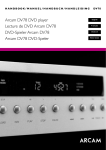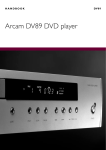Download Panasonic TU-PTA100E Satellite TV System User Manual
Transcript
TU-PTA100E Receiver Operating Instructions English TQBC0200 WELCOME Dear Panasonic Customer, Welcome to the Panasonic family of customers. We hope that you have many years of enjoyment from your new receiver. This is a very advanced receiver; however, the Quick Start Guide will allow you to use the receiver as quickly as possible. You can then read the instructions completely and retain them for future reference. CONTENTS WARNINGS AND PRECAUTIONS . . . . . . . . . . . . . . . . 2 OSD LANGUAGE. . . . . . . . . . . . . . . . . . . . . . . . . . . . . 22 ACCESSORIES . . . . . . . . . . . . . . . . . . . . . . . . . . . . . . . 3 AV SELECT AND SETUP . . . . . . . . . . . . . . . . . . . . . . 23 QUICK START GUIDE . . . . . . . . . . . . . . . . . . . . . . . . . . 4 Q-LINK . . . . . . . . . . . . . . . . . . . . . . . . . . . . . . . . . . . . . 24 BASIC CONTROLS . . . . . . . . . . . . . . . . . . . . . . . . . . . . 7 VCR / DVD OPERATION . . . . . . . . . . . . . . . . . . . . . . . 25 USING THE ON SCREEN DISPLAYS . . . . . . . . . . . . . . 8 TELETEXT OPERATION . . . . . . . . . . . . . . . . . . . . . . . 26 ASPECT CONTROLS . . . . . . . . . . . . . . . . . . . . . . . . . . 9 AUDIO / VIDEO CONNECTIONS . . . . . . . . . . . . . . . . . 28 STILL CONTROL . . . . . . . . . . . . . . . . . . . . . . . . . . . . . 11 PICTURE MENU . . . . . . . . . . . . . . . . . . . . . . . . . . . . . . 12 Front AV3 4 pin S-Video, RCA Audio / Video and Headphone Sockets . . . . . . . . . . . . . . . . . . . . . . . . 28 SOUND MENU . . . . . . . . . . . . . . . . . . . . . . . . . . . . . . . 13 Scart and S-Video Socket Information . . . . . . . . . . . . . 28 SETUP MENU . . . . . . . . . . . . . . . . . . . . . . . . . . . . . . . 14 Rear AV1/AV2(S)/AV4(S) 21 Pin Scart . . . . . . . . . . . . . 29 TUNING MENU - overview . . . . . . . . . . . . . . . . . . . . . 15 TROUBLE - SHOOTING . . . . . . . . . . . . . . . . . . . . . . . 30 TUNING MENU - PROGRAMME EDIT . . . . . . . . . . . . 16 FOR YOUR GUIDANCE . . . . . . . . . . . . . . . . . . . . . . . . 31 TUNING MENU - AUTO SETUP . . . . . . . . . . . . . . . . . 20 SPECIFICATIONS . . . . . . . . . . . . . . . . . . . . . . . . . . . . 31 TUNING MENU - MANUAL TUNING . . . . . . . . . . . . . . 21 WARNINGS AND PRECAUTIONS BThis receiver is designed to operate on A.C. 220 V-240 V, 50 Hz/60 Hz. 2 Place the receiver on a flat, level surface. Adequate ventilation is essential to prevent failure of electrical components. Do not place anything heavy on it. Do not remove the cover, as live parts are accessible when it is removed. Avoid location subject to excessive vibration. Do not insert foreign objects into the Ventilation Holes. WARNINGS AND PRECAUTIONS Do not damage the AC cord. (If damage occurs, replace immediately to avoid fire or shock hazards.) Avoid exposing the Receiver to direct sunlight and other heat sources. To prevent damage which might result in fire or electrical shock hazard, do not expose the Receiver to rain or excessive moisture. ACCESSORIES Check that you have the accessories and items shown Operating Instruction book Remote Control Transmitter EUR511223 Guarantee Card Batteries for the Remote Control Transmitter, (2 x R6(UM3) size) Ferrite sleeve TSK 1027 AC cable TSXA151 RGB cable TSXF199 HD/VD cable TSXF200 Audio cable TSXF201 Remote control batteries Clamper BMake sure that the batteries are fitted the correct way round. BDo not mix old batteries with new batteries. Remove old, exhausted batteries immediately. BDo not mix different battery types, i. e. Alkaline and Manganese or use rechargeable (Ni-Cad) batteries. 3 QUICK START GUIDE Quick Start Guide 1 Connections Wide Plasma Display PR/R PB/B L Y/G AUDIO VD HD R COMPONENT/RGB IN HD/VD cable (Supplied) (Cable with black plug) RGB cable (Supplied) * The HD/VD cable has a white line marked on it for identification. Do not connect any other cables to the same signal connector by mistake. Audio cable (Supplied) (Cable with red and white plug) AC cable (Supplied) Ferrite sleeve (Supplied) OR Plug in aerial and connect ancillary equipment Note: Additional equipment and cables shown are not supplied with this set. Installing the ferrite sleeve 1 3 Pass the cable through and close % $ Pull back the tabs (in two places) # (For a thick cable) 2 Open Pass the clamper through the hole. Clamper Hole 4 Tighten the clamper to secure the cable. QUICK START GUIDE 2 Preparing the Wide Plasma Display # Turn on the power INPUT Power Switch $ Make the COMPONENT/RGB IN setting Set up Access Change Select Select COMPONENT/RGB IN Y/PB/PR RGB Picture Sound Panasonic Auto (4:3) 4:3 Just Signal OSD Language Set up English MENU Exit MENU BPress the MENU button. BAccess the COMPONENT/RGB IN BAccess the Set up. BSelect the RGB. BPress the STR button. MENU BPress the MENU button to exit. STR Note: Use the remote control unit for the Wide Plasma Display to make the setting. % & RGB BChange the input signal mode to RGB. Note: Change the input selection at the Wide Plasma Display. INPUT 16:9 B Set the aspect mode to 16:9. MANUAL-ASPECT- Note: Use the remote control unit for the Wide Plasma Display to make the setting. 5 QUICK START GUIDE 3 Operating the receiver # First, ensure that the VCR is in Standby mode. Plug in receiver and switch on $ % Land Deutschland Österreich France Italia España Nederland Danmark Sverige Norge Suomi Belgien Schweiz E.Eu AUTO SETUP IN PROGRESS SEARCHING : PLEASE WAIT Stored : CH44 XYZ 02 TV/AV : To exit Auswählen OSD Sprache Deutsch Start ATP CH44 99:21 41 Auswählen Suchlauf Abbruch Select your country For Switzerland and Belgium, select the desired language Auto setup will begin, your stations will be located and stored. If a compatible VCR is connected to the AV2 socket, programme data will be downloaded to the VCR via Q-Link. See page 24. Press the red button & If you are installing a new Q-Link compatible VCR, you can now switch it ON. Downloaded tuning data will match the receiver’s. If you are installing a new NEXTVIEWLINK compatible VCR, you will need to initiate download manually. See the VCR handbook for details. Adjust Volume Change Channel BIf the VCR has not accepted download data from the receiver, you may need to select the Download option from the VCR’s menu. BIf Q - LInk is not operating correctly, check it is connected to the receiver’s AV2 socket, the SCART lead is a “full function” type, and the VCR is compatible with Q - Link, NEXTVIEWLINK or similar technologies. Ask your dealer for further details. BFor further information on Q - Link and connecting equipment, see pages 24, 28 and 29. 6 BASIC CONTROLS: FRONT PANEL AND REMOTE CONTROL Power On/OFF switch Power Indicator ( ) The Power Indicator will light. Power-OFF.....Indicator not illuminated (The unit will still consume some power as long as the power cord is still inserted into the wall outlet.) Stand-by .....Red Power-ON.....Green STR (Normalisation store) Used to store tuning and other function settings F (Function select) Displays the On Screen Display functions, use repeatedly to select from the available functions Volume, Contrast, Brightness, Colour, Sharpness, Tint (in NTSC mode), Bass, Treble, Balance (in Normal 2 channel stereo mode), Tuning. RCA Audio/Video sockets (page 28) S-VHS socket (see page 28) Headphone socket (see page 28) TV/AV switch (see page 23) Increase or decreases the programme position by one. When a function is already displayed, press to increase or decrease the selected function. When in Standby mode, switches receiver On. Standby ON/OFF switch Switches receiver On or Off standby. Sound mute On/Off Menu buttons Press to access the Picture, Sound and Setup menus (see page 8). Status button Press to display programme position, programme name, channel number, time, MPX mode, Aspect mode and programme table. Teletext buttons (see page 26). Cursor buttons to make selections and adjustments Switch between viewing TV or AV input (see page 23) Coloured buttons used for Programme Edit functions (see page 16). Teletext functions (see page 26). AV selection (see page 23). Direct TV Record button (see page 24) Aspect control button (see page 9) Wide Plasma Display control button Standby ON/OFF switch INPUT button Press the INPUT button to select AV(S-Video)/Component,RGB/PC input signal modes sequentially. Direct channel access During normal TV viewing or when in the Tuning, Programme edit or Manual tuning menus, press and then enter channel number using the numeric buttons The N button will recall settings stored with STR STR (Normalisation store) Programme/channel change buttons (0 - 9) and Teletext page buttons (see page 26). When in Standby mode, switches receiver on. Programme position for selection of two digit programmes (10 - 99) using numeric buttons. VCR/DVD buttons (see page 25) The Help button provides a demonstration of On Screen Display menus. 7 USING THE ON SCREEN DISPLAYS This receiver has a comprehensive system of On Screen Display menus to access adjustments and options Select Change Menu Title Options Selection bar TV/AV Picture menu Contrast Brightness Colour Sharpness P-NR AI AUTO Normal Some selections, for example, Contrast, Brightness, Colour and Sharpness will allow you to increase or decrease their level. Some selections, for example, Off timer, allow a change of setting to be made. Some selections, for example Tuning menu, will lead to a further menu. The PICTURE, SOUND and SET UP buttons are used to open the main menus and also to return to the previous menu. The up and down cursor buttons are used to move the cursor up and down the menus. The left and right cursor buttons are used to access menus, adjust levels or to select from a range of options. The STR button is used to store settings after adjustments have been made or options have been set. The TV/AV button is used to exit the menu system and return to the normal viewing screen. The HELP button will run a demonstration of the menus available. Press the HELP button and select one of the options. Note: If no operations are carried out, the menu display will be cleared after approximately 1 minute. 8 Instructions Exit Indicator for options ASPECT CONTROLS The receiver will allow you to enjoy viewing the picture at its maximum size, including widescreen ‘cinema format’ pictures. Press the ASPECT button to move through the six aspect options: Panasonic Auto, 4:3, Zoom, S-Zoom, 16:9 and Just Panasonic Auto Some broadcasts are transmitted together with a wide screen identification signal (WSS). If the receiver receives this signal then it will automatically switch to wide screen 16:9 mode, maximum display. The automatic widescreen switching depends upon reception conditions and the strength of the signal. If the signal is poor and therefore the WSS is weak then it is possible that the picture may not expand to full size and that the receiver will display black areas around the edges. If the original source signal was a standard 4:3 aspect ratio then you might prefer to view it in its original size; the red and green keys that appear will allow you to choose between viewing at standard 4:3 size or expanded in Just mode. Panasonic Auto 4:3 4:3 will display a 4:3 picture at its standard 4:3 size and can be selected if you wish to view in this format. Note: After setting this mode, turn the power off and back on again to activate the Just mode setting. 4:3 Zoom Zoom mode magnifies the central section of the picture. The picture can be moved and enlarged vertically using the colored keys. The former adjustment is useful for viewing any sub-titles which may appear outside the picture. Zoom 9 ASPECT CONTROLS The on screen selector keys that appear for some aspect functions will clear after a few seconds. If you subsequently wish to select an operation then press the Aspect key once more for the keys to reappear. The widescreeen aspect ratios of different films and programmes can vary. If these are wider than a standard 16:9 aspect picture then a black band may be visible at the top and bottom of the screen. If, in Panasonic Auto mode, you experience problems with the screen display size when playing back widescreen format recordings from your VCR then it is possible that the tracking control of your VCR requires adjustment (your VCR instruction book will contain adjustment details). Blue key has been pressed to move picture upwards S-Zoom S-Zoom allows increased magnification and the ability to move the picture horizontally and vertically. Increased magnification with S-Zoom 16:9 16:9 will display the picture at its maximum size but with slight elongation. 16:9 Just Just mode will display a 4:3 picture at maximum size but with aspect correction applied to the centre of the screen so that elongation is only apparent at the left and right edges of the screen. The size of the picture will depend on the original signal. Just 10 STILL CONTROL STILL Control The STILL key allows you to freeze the picture at any time. 11 PICTURE MENU Open the Picture menu Move to your choice Select Increase or decrease levels or set options Press the TV/AV button to exit the Picture menu Adjust TV/AV Picture menu Contrast Brightness Colour Sharpness P-NR AI Exit AUTO Normal Contrast Brightness The Contrast, Brightness, Colour and Sharpness levels can be adjusted to suit your own preferences. Colour Select Adjust Sharpness TV/AV Picture menu Tint P-NR AI The Tint adjustment will only appear as a menu item if you have an NTSC signal source connected to the receiver and will allow adjustment of the hue. Contrast Brightness Colour Sharpness P-NR AI P-NR will automatically reduce unwanted picture noise. AI automatically analyses the incoming picture and processes it to give improved contrast and optimum depth of filed. Sharpness 12 AUTO Normal Exit SOUND MENU Open the Sound menu Select Move to your choice Adjust TV/AV Sound menu Increase or decrease levels or set options Press the TV/AV button to exit the Sound menu Volume Treble Balance On Stereo Music The Volume adjustment sets the overall output volume. Note: At the time of shipment from the factory, the volume is set to the maximum level. The Wide Plasma Display also has a volume setting control, so the maximum volume is determined by the volume control settings at both the receiver and the Wide Plasma Display. Bass Volume Bass Treble Balance Headphone volume AI MPX Mode Exit Bass adjustment will emphasise the lower, deeper frequencies and can be increased or decreased. Treble adjustment will emphasise the sharper, higher frequencies and can be increased or decreased. Select Change TV/AV Sound menu Volume Bass Treble Balance Headphone volume AI MPX Mode Exit On Stereo Music Balance affects the levels of sound between the left and right speakers. Adjustment can be made so that the level from the speakers will suit your listening position. Select Change The headphone volume can be adjusted independently of the receiver’s AUDIO OUT terminals so that everyone can enjoy listening at their own comfort level. AI MPX Mode The Al setting automatically analyses the incoming sound signal and processes it to give lower noise and optimum tone for the programme material. TV/AV Sound menu Volume Bass Treble Balance Headphone volume AI MPX Mode Exit Off Stereo Music MPX will usually be set to Stereo to provide the best reproduction, however if reception deteriorates or if the service is not available than it is advisable to switch to Mono. Mono (M1) and (M2) can also be selected if signals are being transmitted. Bass and Treble are set to the optimum levels for music or speech. 13 SETUP MENU The Setup menu provides access to various advanced features and also to the Tuning menu Open the Setup menu Select Move to your choice Change Increase or decrease levels, set options or access further menus Setup menu Press the TV/AV button to exit the Setup menu AV2 out Teletext Off timer Q-Link Tuning menu OSD language AV2 out TV/AV Exit TV TOP Off On Access Access AV2 offers you a choice of signals to send to the AV2 SCART socket. You can choose from the current TV programme position, the signal entering AV1/AV3/AV4 or Monitor the picture displayed on screen. Select Change Teletext Off timer The Teletext option allows you to choose between FLOF/TOP or LIST mode. See page 26. Off timer will switch the receiver off within a present time which you can choose from between 0 to 90 minutes in 15 minute intervals. TV/AV Setup menu AV2 out Teletext Off timer Q-Link Tuning menu OSD language Exit TV TOP Off On Access Access Note: This function will not turn off the power for the Wide Plasma Display. If you would like to use the off timer for the Wide Plasma Display, use the Wide Plasma Display’s own off timer function. Select Change Q-Link Q-Link allows you to enable or disable data communication when a VCR compatible with Q-Link, NEXTVIEWLINK or similar technology is connected. See page 24. The Tunging menu provides an entry to many other features including Programme edit and Auto setup. See page 15. OSD Language 14 OSD Language allows you to select the language used for On Screen Displays. See page 22. TV/AV Setup menu AV2 out Teletext Off timer Q-Link Tuning menu OSD language TV TOP Off Off Access Access Exit TUNING MENU - overview Open the Setup menu Move to Tuning menu Select Access Tuning menu Change Move to your choice Setup menu Increase or decrease levels, set options or access further menus AV2 out Teletext Off timer Q-Link Tuning menu OSD language TV/AV Exit TV TOP Off On Access Access Press the TV/AV button to exit Accessing the Programme edit menu will allow stations to be moved, added, deleted, named or locked. See page 16. Select Access The Auto setup menu allows you to automatically retune the receiver. See page 20. AV2 out Teletext Off timer Q-Link Tuning menu OSD language The Manual tuning menu allows individual programme positions to be tuned manually. see page 21. Fine tuning TV/AV Setup menu Exit TV TOP Off On Access Access Small adjustments to tuning can be made using the Fine tuning function. 1 Select CH41 Colour system The Colour system menu allows you to decide the correct choice of transmission standard. Access Return TV/AV 'STR' Button Exit Store Tuning menu Volume correction Decoder (AV2) Volume correction allows you to adjust the volume level of individual stations. This option is used when a decoder is connected via AV2. Set to On if a scrambled signal is to be processed by the decoder. Set to Off after use. Programme edit Auto setup Manual tuning Fine tuning Colour system Volume correc. Decoder (AV2) Access Access Access AUTO Off 15 TUNING MENU - PROGRAMME EDIT The Programme edit menu allows you to edit the programme position settings. Open the Setup menu Select Change Move to Tuning menu TV/AV Setup menu AV2 out Teletext Off timer Q-Link Tuning menu OSD language Access Tuning menu Move to Programme edit menu Exit TV TOP Off On Access Access Access Programme edit menu Make required changes (see sections below) Select Access TV/AV Setup menu Press STR button to store changes AV2 out Teletext Off timer Q-Link Tuning menu OSD language If you have finished in the Programme edit menu, press the TV/AV button to exit. Exit TV TOP Off On Access Access 1 To delete an unwanted programme position Ensure that the cursor is in the Prog. Column Choose the programme position Press the Red button on remote control Select CH41 Access Return TV/AV 'STR' Button Tuning menu Programme edit Auto setup Manual tuning Fine tuning Colour system Volume correc. Decoder (AV2) Access Access Access AUTO Off Change programme Press the Red button again to confirm Select option Return If you have finished in the Programme edit menu, press the TV/AV button to exit. Note: The Decoder (AV2) option in the Tuning menu and the TV→VCR option in the Programme edit menu are only displayed when Q-Link in the Setup menu has been set to ON. 16 Exit Store TV/AV 'STR' Button Exit Store Programme edit Prog. 1: 2: 3: 4: 5: Delete Chan. CH41 − − − − Name XYZ Add Lock Off Off Off Off Off Move Sys SC1 SC1 SC1 SC1 SC1 TV → VCR TUNING MENU - PROGRAMME EDIT To add a programme position Choose the programme position where the new programme is to be inserted. Change programme Select option Return TV/AV 'STR' Button Press the Green button Exit Store Programme edit Press the Green button again to confirm. This blank programme can then be tuned, named or locked. Prog. 1: 2: 3: 4: 5: Chan. CH41 − CH44 − − Name XYZ Lock Off Off Off Off Off ZXY Delete Add Sys SC1 SC1 SC1 SC1 SC1 TV → VCR Move Press STR to store If you have finished in the Programme edit menu, press the TV/AV button to exit. To move a programme to another position Change programme Choose the programme position to be moved Select option Return TV/AV 'STR' Button Press the Yellow button on remote control. Choose new position. Programme edit Prog. 1: 2: 3: 4: 5: Chan. CH41 − CH44 − − Name XYZ Lock Off Off Off Off Off ZXY Delete Add Change programme Select option Return TV/AV 'STR' Button Note: The TV→VCR option in the Programme edit menu is only displayed when Q-Link in the Setup menu has been set to ON. Sys SC1 SC1 SC1 SC1 SC1 TV → VCR Move Press the Yellow button again to confirm. If you have finished in the Programme edit menu, press the TV/AV button to exit. Exit Store Exit Store Programme edit Prog. 1: 2: 3: 4: 5: Delete Chan. CH41 − − − CH44 Name XYZ Lock Off Off Off Off Off ZXY Add Move Sys SC1 SC1 SC1 SC1 SC1 TV → VCR 17 TUNING MENU - PROGRAMME EDIT To tune a programme position Choose the programme position. Change channel Select option Return Move the channel column TV/AV 'STR' Button Exit Store Programme edit Increase or decrease channel number or use the ‘C’ key for Direct Channel Access (see page 7). Press STR to store. Prog. 1: 2: 3: 4: 5: Chan. CH41 − CH44 − − Name XYZ ZXY Lock Off Off Off Off Off Sys SC1 SC1 SC1 SC1 SC1 If you have finished in the Programme edit menu, press the TV/AV button to exit. To rename a programme position Change character Choose the programme position Select option Return TV/AV 'STR' Button Move to the Name column Choose the new character Move to the next character position Continue until renaming is done. Press STR to store If you have finished in the Programme edit menu, press the TV/AV button to exit. 18 Exit Store Programme edit Prog. 1: 2: 3: 4: 5: Chan. CH41 − CH44 − − Name XYZ ZXY ABCDEFGH I J KLM NOPQRSTUVWXYZ +− . 012 34 5 6 789 Lock Off Off Off Off Off Sys SC1 SC1 SC1 SC1 SC1 TUNING MENU - PROGRAMME EDIT To lock a programme position to prevent access Choose the programme position. Lock off/on Select option Return Move to the lock column. TV/AV 'STR' Button Exit Store Programme edit Choose between lock On or lock Off Press STR to store. If you have finished in the Programme edit menu, press the TV/AV button to exit. Prog. 1: 2: 3: 4: 5: Chan. CH41 − CH44 − − Name XYZ Lock Off Off Off Off Off ZXY Sys SC1 SC1 SC1 SC1 SC1 Note: When a programme position is locked, Direct Channel Access using the ‘C’ and numeric keys on the remote control is not available. To change the TV-system for a programme position Choose the programme position Change TV system Move to the Sys column Choose the required sound system: SC1 : PAL B, G, H / SECAM B, G SC2 : PAL I SC3 : PAL D, K / SECAM D, K F : SECAM L/L’ Press STR to store Select option Return TV/AV 'STR' Button Exit Store Programme edit Prog. 1: 2: 3: 4: 5: Chan. CH41 − CH44 − − Name XYZ Lock Off Off Off Off Off ZXY Sys SC1 SC1 SC2 SC1 SC1 If you have finished in the programme edit menu, press the TV/AV button to exit To copy programme information to a compatible VCR connected to AV2 Change programme Move to the Prog. Column. Select option Return TV/AV 'STR' Button Press the Blue button on the remote control. Programme data will now be sent to the VCR. This might take a few seconds, depending on the number of stations stored. If you have finished in the Programme edit menu, press the TV/AV button to exit. Exit Store Programme edit Prog. 1: 2: 3: 4: 5: Delete Chan. CH41 − − − − Name XYZ Add Lock Off Off Off Off Off Move Sys SC1 SC1 SC1 SC1 SC1 TV → VCR Note: The TV→VCR option in the Programme edit menu is only displayed when Q-Link in the Setup menu has been set to ON. 19 TUNING MENU - AUTO SETUP The Auto setup menu will allow you to automatically retune the receiver to your local stations. 1 Select It is useful if you move to a different region. CH41 Access Return Open the Setup menu TV/AV 'STR' Button Exit Store Tuning menu Move to Tuning menu Programme edit Auto setup Manual tuning Fine tuning Colour system Volume correc. Decoder (AV2) Access Access Access AUTO Off Access Tuning menu Move to Auto setup WARNING All current tuning data will be erased Access Auto setup Start Auto setup Return TV/AV Press to continue Select your country Press to start Auto setup Country Deutschland Österreich France Italia España Nederland Danmark Sverige Norge Suomi Belgium Schweiz E.Eu Select country The receiver will search for, locate and sort into order your local stations. If a compatible VCR is connected via the AV2 socket, programme data will be sent to the VCR via Q-Link (see page 24). Once this operation is completed the receiver will display programme position 1. Exit Start Auto Setup Return TV/AV Exit CH44 AUTO SETUP IN PROGRESS SEARCHING : PLEASE WAIT Stored : CH44 XYZ 02 SETUP : Return to tuning menu TV/AV : To exit 20 99:21 41 TUNING MENU - MANUAL TUNING Manual tuning of the programme positions is available either from the On Screen Display menu or from the front panel controls. Manual tuning menu Open the Setup menu 1 Select CH41 Access Return Move to Tuning menu TV/AV 'STR' Button Exit Store Tuning menu Programme edit Auto setup Manual tuning Fine tuning Colour system Volume correc. Decoder (AV2) Access Tuning menu Move to Manual tuning Access Manual tuning Select the programme position to be tuned. Access Access Access AUTO Off 1 CH41 Press repeatedly until required station is found. Programme down/up Search down/up Return When the desired station is found, press STR to store. The programme position will flash. TV/AV 'STR' Button Exit Store Manual tuning Press the TV/AV button to exit. 02 99:21 41 99:21 41 Manual tuning (Front panel) Press the F button (Front panel) until “Tuning mode” is reached. 1 Press the TV/AV button to move between “Change programme”, “Search” and “Change TV system”. Press the – or + button to change the programme position, start searching, or change TV system. When the desired station is found, press STR to store. The programme position will flash. CH44 Manual tuning (Front panel) −,+ TV/AV STR F : : : : Search Move cursor To store To exit 02 STR F −/V +/ V Press the – or + button to access Tuning mode. TV/AV Repeat above procedure to tune additional programmes or press the F button to exit. 21 OSD LANGUAGE When you first installed the receiver the On Screen Display language was set according to your choice of country. If you wish to use a different language then it can be chosen from the OSD language menu Open the setup menu Select Access Move to the OSD language menu TV/AV Setup menu Access the OSD language menu AV2 out Teletext Off timer Q-Link Tuning menu OSD language TV TOP Off On Access Access Move to your choice Press the TV/AV button to select and exit Select Select Return TV/AV Exit OSD language Deutsch English Français Svenska 22 Español Norsk Dansk Nederlands Suomi Italiano Exit AV SELECT AND SETUP The AV Select menu will allow you to choose which AV source to view. Press the TV/AV button Press the appropriate coloured remote control button (whilst the options remain on screen). The options will disappear. You may wish to make adjustments in the Setup or Sound menus. Setup menu Open the Setup menu. Select Adjust Move to your choice. TV/AV Setup menu Access adjustments or options. Press the TV/AV button to exit. AV2 out Teletext Off timer Colour system Volume correc. Q-Link OSD language Exit TV TOP Off Auto On Access Sound menu Open the Sound menu Select Adjust Move to your choice TV/AV Sound menu Access adjustments or options. Press the TV/AV button to exit. Volume Bass Treble Balance Headphone volume AI Mode Exit On Music 23 Q-LINK Q-Link allows the receiver to communicate with your VCR. This function can be used to automatically turn the power switches of the receiver and the VCR on and off, but it cannot be used to turn the power switch of the Wide Plasma Display on and off. Use the remote control unit to turn the power switch of the Wide Plasma Display on and off. Open the Setup menu Select Move to Q-Link Change TV/AV Setup menu Confirm Q-Link is set to “On” AV2 out Teletext Off timer Q-Link Tuning menu OSD language Press the TV/AV button to exit Exit TV TOP Off On Access Access The VCR must be connected with a SCART lead (full function type) attached between the AV2 socket of the receiver and the appropriate socket on your VCR. See the VCR handbook for further information. Q-Link, NEXTVIEWLINK or similar technology allows the receiver to instruct a compatible VCR to record the programme that is currently being displayed on screen, regardless of the programme position set on the VCR, thus simplifying the process of recording programmes. To record the programme you are currently watching Press the DIRECT TV REC button on the remote control. If the VCR is off, it will automatically switch on when you press the DIRECT TV REC button. A message, sent from the VCR, will appear on screen showing what is being recorded, or if it is not possible to record; VCR recording preset prog VCR recording TV source VCR recording own tuner VCR is recording the programme signal from the receiver. You must not change programme position or switch off the receiver: if you do, the VCR will automatically stop recording and switch off. VCR is recording the programme signal from its own tuner. If you wish you can switch off the receiver and leave the VCR recording in the normal way. No recording TAPE IS PROTECTED The write protection tab on the back of the cassette has been removed. Examples of other messages that might be displayed are: No recording NO TAPE No recording VCR ALREADY RECORDING No recording VCR IS PLAYING No recording TAPE MAY BE DAMAGED VCR Recording VCR external No recording NO SOURCE AVAILABLE To share tuning information To ensure correct recordings are made, the receiver and VCR should share tuning information - see page 20. B Whenever the Auto setup (ATP) function is used, tuning data will be downloaded to the VCR. Auto Power Functions With Panasonic Q-Link VCRs these additional features are available: B If you insert a tape in your VCR and press the Play button, the receiver will automatically switch on and select the AV2 input so you can view the tape. B If you switch off the receiver whilst the VCR is in Stop, Fast Forward or Rewind modes, the VCR will switch off automatically. To turn off Q-Link communication If you do not wish to use the Q-Link feature, go to the Setup menu and set the Q-Link option to “Off”. See page 14. Important Note: Not all VCRs support this type of data communication system. Some may support certain features, but not others. See the VCR handbook for further information. If Q-Link is inoperative, first confirm that your SCART lead is a full function type. Ask your dealer for further details. 24 VCR/DVD OPERATION The Remote Control is capable of operating some functions of selected Panasonic VCRs and DVD (Digital Versatile Disc) equipment. Some VCR and DVD equipment have different functions, so to ensure compatibility please refer to the equipment’s instruction book or consult your dealer for details. Standby Press to switch the VCR or DVD to standby mode. Press again to switch back on. VCR/DVD switch Use this switch to select whether controls operate DVD equipment or your VCR. Play Press to playback the tape or DVD. Stop Press to stop the tape or DVD. Skip/Fast Forward/Cue VCR: Press to fast forward the tape. In Play mode, press to view the picture rapidly forward (Cue). DVD: Press once to skip to the next track. In play mode press and hold to view the picture rapidly forward. Skip/Rewind/Review VCR: Press to rewind the tape. In Play mode, press to view the picture rapidly in reverse (Review). DVD: Press once to skip to the previous track. In play mode press and hold to view the picture rapidly in reverse. Pause/Still Press in playback mode, the picture will pause. Press again to restart play. Programme Up/Down Press to increase or decrease the VCR programme position by one. Record Press this button to start recording. 25 TELETEXT OPERATION B Teletext features may vary depending on the Broadcasting Companies and is only available if the channel selected is transmitting Teletext. to alter B Pressing the Picture button whilst in Teletext mode will display the Brightness function with a white bar. Press the setting as required. Pressing the Setpu button whilst in Teletext operation will display special function options at the bottom of the screen. B When in Teletext mode, the volume may still be altered to the desired listening level. What is LIST mode? In LIST mode, four differently coloured page numbers are situated at the bottom of the screen. Each of these numbers can be altered and stored in the receiver’s memory. What is FLOF? In FLOF mode, four differently coloured subjects are situated at the bottom of the display. To access more information about one of these subjects, press the appropriately coloured button. This facility enables fast access to information on the subjects shown. TV/Teletext mode Press the TV/TEXT button. The screen will display the Teletext page. Press again when you wish to return to TV mode. Page selection Pages can be selected in two ways: a. Press the Up/Down buttons to increase or decrease the page number by one. b. By entering the page number, using 0 - 9 on the remote control. Full/Top/Bottom Press the SET UP button to display special functions, followed by the Green button. Press the Green button again to expand the BOTTOM half. Press again to return to normal (FULL) size. Reveal Press the SET UP button to display special functions, followed by the Red button to reveal hidden words e.g. quiz page answers. Press again to hide. Red/Green/Yellow/Blue buttons In FLOF mode these correspond to the differently coloured subjects. In LIST mode they correspond to the differently coloured page numbers. List Store In LIST mode the four page numbers can be altered (programme positions 1 - 25 only). To do this, press one of the four coloured buttons and enter the new page number. Press and hold STR, the page numbers will change to white indicating that the page is stored. Hold To hold the Teletext page when viewing multi-page information. Press again to return to automatic page update. 26 TELETEXT OPERATION It is not possible to change the programme position when in News flash, Update or Sub Coded Page Access operation. Favourite Page (F.P.) Stores a favourite page in memory for instant recall. To store such a page, the receiver must be in LIST mode, and the programme position must be from 1 - 25. Press the Blue button, select the page number, then press and hold the STR button. The page number is now stored. Press F.P. to recall this page. Update Display Press the SET UP button to display special functions, followed by the Yellow button to view the TV picture whilst searching for a Teletext page. When found, the screen will display the page number at the top left. Press the Yellow button to view the page. Press TV/TEXT again to return to normal TV operation. News Flash When a new flash page has been selected, press SET UP, Yellow, to view the TV picture. When an update is received, the page number will be displayed on screen. Press the Yellow button to display the News Flash. Press TV/TEXT to return to normal TV operation. Update Press SET UP, Yellow to see the update of information on certain pages. When an update is received, the page number will be displayed at the top left of the screen. Press the Yellow button to view the page. Press TV/TEXT to return to normal TV operation. Sub Coded Page Access When Teletext information exceeds more than one page, it may take some time for the automatic changing of the sub pages to reach the sub page you require. It is possible to enter your required sub page and continue watching the normal programme until the correct sub page is found. Select the required page number using buttons 0 - 9. Press the SET UP button to followed by the Blue button; T**** will be displayed at the top right of the screen. Enter desired sub page number before the T**** disappears. To select page 6 enter 0, 0, 0 and 6. (If in LIST mode, a ‘T’ will appear in the current box at the bottom). Press the Yellow button to view a normal TV programme. (Press SET UP, Yellow in LIST mode.) When the page is available, press the Yellow button to view the page. To clear the page perform one of the following: B Press SET UP. B Select a new page number. B Press TV/TEXT to return to normal TV operation. Index When in FLOF operation Press INDEX to return to the main index page. Depending on the way information is transmitted, this may have to be pressed more than once to return to the main index page. 27 AUDIO/VIDEO CONNECTIONS Front AV3 4 pin S-Video, RCA Audio/Video and Headphone Sockets Output from Headphones socket Video input to S-V S-Video socket Audio input to L/R sockets Video input to V socket 3.5 mm Stereo Plug 2 x RCA Audio cables RCA Video cable CAMCORDER STEREO HEADPHONES with 3.5 mm Plug Note: Additional equipment and cables shown are not supplied with this receiver. ■ Scart and S-video socket information AV1 and AV4 Scart sockets Socket Earth CVBS out (video) CVBS earth Red in Red earth Green in Green earth Blue in Blue earth Audio out (L) Audio out (R) AV2 Scart socket (S-Video, Q-Link) CVBS in (video) RGB status earth Status RGB Earth –– –– Status CVBS Audio in (L) Audio earth Audio in (R) Suitable inputs for AV1 include RGB (Red/Green/Blue). AV4 does not have RGB input capability. Socket Earth CVBS out (video) CVBS earth S.C. - In Earth –– Earth –– Earth Audio out (L) Audio out (R) CVBS in (video) Earth –– Earth –– Q-Link data Status CVBS Audio in (L) Audio earth Audio in (R) AV2 - Pins 15 and 20 are dependent on AV2 S - VHS/VIDEO switching. S-Video 4 pin socket Chrominance in Chrominance earth 28 Luminance in Luminance earth AUDIO/VIDEO CONNECTIONS Rear AV1/AV2(S)/AV4(S) 21 Pin Scart Input/Output from AV4 Scart Socket Scart cable VCR S-VIDEO VCR Input/Output from AV2 Scart Socket Q-Link data Scart cable Input/Output from AV1 Scart Socket Scart cable VCR S-VIDEO VCR Q-LINK COMPATIBLE VCR SATELLITE RECEIVER VCR SATELLITE RECEIVER S-VIDEO CAMCORDER S-VIDEO CAMCORDER CAMCORDER GAMES CONSOLE/COMPUTER (RGB) Notes: Additional equipment and cables shown are not supplied with this receiver. Do not connect a computer with TTL output (5V) to this set. The AV2 21 pin terminal can also be used as an output to Audio/Video equipment; see page 14 for details. 29 TROUBLE-SHOOTING Symptoms Picture Checks Sound Aerial location, direction or connection Snowy Picture Noisy Sound Aerial location, direction or connection Multiple Images Normal Sound Electrical appliances Cars/Motorcycles Fluorescent lights Interference Noisy Sound (Receiver or Wide Plasma Display) Volume level Normal Picture No Picture No Sound No Sound Sound mute switched on (Receiver or Wide Plasma Display) Receiver to AV mode Wide Pladma Display is not set to RGB mode. Not plugged into A.C. outlet Not switched on Picture/Sound controls set at minimum levels Check if in standby mode Colour system (If the picture and sound disappear when the colour system is changed, wait approximately 45 seconds. The unit will then switch automatically to Auto mode.) (Receiver or Wide Plasma Display) Colour controls set at minimum levels No Colour Normal Sound Retune Channel(s) Poor or Distorted Picture Weak or No Sound Sound reception may have deteriorated. Switch MPX setting (Sound menu) to Off until reception improves. Normal Picture 30 Weak or distorted sound FOR YOUR GUIDANCE ■ Service ■ Last Position Memory Before requesting service, please refer to the troubleshooting guide on previous page to determine the symptoms. To obtain service please contact your local Panasonic dealer quoting the model number and serial number (both are located at the rear of the receiver). Certain functions have a last position memory, i.e. the setting at the time of switch - off will be the setting used when the receiver is switched on again: Headphone volume (M.NTSC/NTSC only) ■ Sleep Feature AV position Contrast If the set is not switched off when the TV station stops transmitting, it will automatically go to standby mode after 30 minutes. This function will not operate when the receiver is in AV mode. Volume Sharpness Programme Tint MPX Aspect (except 4:3) Bass Standby Treble Artificial Intelligence (AI) Balance (Picture & Sound) Status Colour Teletext mode Brightness Decoder (AV2) P-NR Q-Link Volume correction (in AV mode only) SPECIFICATIONS TU - PTA100E 220 V - 240 V 50 Hz/60 Hz A.C. Power Source Power Consumption 23 W Standby Consumption 2.8 W 2.1 W Power-OFF Consumption 0.7 V[p-p] RGB Output 0.5 V[rms] (Volume max) AUDIO Output Dimensions H W D 121.4 mm 430 mm 349.5 mm g) Weight (kg Receiving Systems/ Band name 5.1 kg PAL B, G, H, I, SECAM B, G SECAM L/L’ VHF E2 - E12 VHF H1 - H2 (ITALY) VHF A - H (ITALY) UHF E21 - E69 CATV (S01 - S05) CATV S1 - S10 (M1 - M10) CATV S11 - S20 (U1 - U10) CATV S21 - S41 (Hyperband) PAL D, K, SECAM D, K VHF R1 - R2 VHF R3 - R5 VHF R6 - R12 UHF E21 - E69 PAL 525/60 Playback of NTSC tape from some PAL video recorder (VCR) M.NTSC Playback from NTSC 4.43 MHz Videorecorders (VCR) NTSC (AV mode only) Playback from NTSC Videorecorders (VCR) Aerial - Rear UHF/VHF 3,5 mm., 8 Ω impedance Headphones - Front AV - Rear AV1 21 pin terminal - Audio/Video in/out RGB in. AV2 - 21 pin terminal - Audio/Video in/out, S-Video in, Q-Link AV4 - 21 pin terminal - Audio/Video in/out, S-Video in AV - Front AV3 - S-Video in, 1 x RCA Video in, 2 x RCA Audio in B Specifications are subject to change without notice. Weight and dimensions shown are approximate. This equipment complies with the EMC standards listed below. EN55013, EN55020 31 Customer’s Record The model number and serial number of this product can be found on its rear cover. You should note this serial number in the space provided below and retain this book plus your purchase receipt as a permanent record of your purchase to aid in identification in the event of theft or loss, and for Warranty Service purposes. Model Number TU - PTA100E Serial Number Matsushita Electric Industrial Co., Ltd. Central P.O. Box 288, Osaka 530 - 8692, Japan Printed in Japan S1099-1109B















































